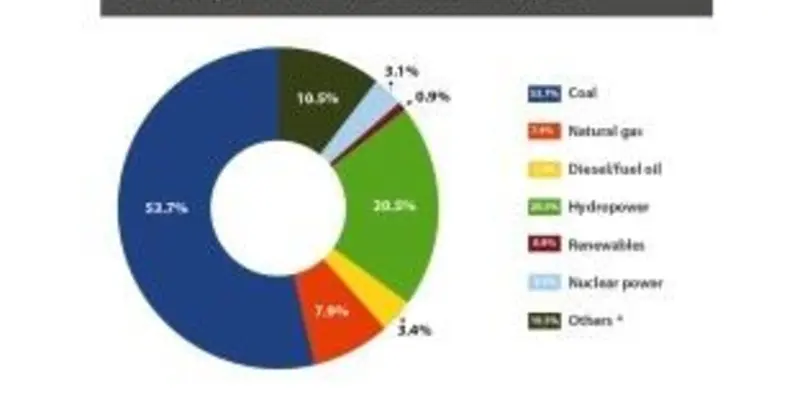Africa continues to lag behind fellow developing regions in installed generation capacity below 100GW and per capita electricity consumption. Economic correspondent Moin Siddiqi reports
Nowadays, around three-fifths of the sub-Saharan Africa (SSA) population of one billion live without power, often resorting to using kerosene or spending hours in darkness, which imposes colossal socio-economic losses upon an energy-rich region. While for those connected to grid electricity supply, crippling power outages are widespread, as cashstrapped utilities (mostly state-owned) are unable to provide reliable services due to underinvestment in infrastructure during the past decades.
Africa continues to lag behind fellow developing regions in installed generation capacity below 100GW and per capita electricity consumption, averaging 40 to 45 kilowatt hours (KWh) per month, compared to 100+ KWh/month in developing countries in regions such as Latin America or South Asia. Also, household access to grid electricity in SSA was estimated by the World Bank to be 35.3 per cent in 2012, which is far lower than 78 per cent; 96.2 per cent; and 94.4 per cent in South Asia, Middle East and South America & Caribbean, respectively.
According to the International Energy Agency (IEA), 15 out of 20 countries in Africa were ranked in the bottom worldwide for per capita consumption of electricity, while 13 out of 20 countries lacking adequate power supply were also located in Africa. Moreover, the disparity between urban and rural areas was noticeable. Over two-thirds of urban residents were estimated to have had access to electricity while only 15 per cent of rural residents were connected (World Bank and IEA 2015). Many households cannot afford high connection fees and tariffs, which limits the expansion of grid electrification. In most countries, connection costs are equivalent to a month’s household spending; though free connections to the national grid are provided for low-income customers in Mozambique, Senegal and South Africa.
Operational bottlenecks
The region’s network system is notoriously unreliable - with one third or more of installed generating capacity remaining non-operational due to ageing plants and poor maintenance. Daily blackouts and bad service force firms and some households to rely on expensive back-up generators that cost US$0.40/ KWh.
Two-fifths of firms surveyed in 2016 cited electricity as a major barrier to doing business in Africa. Also, high costs of small-scale operations and heavy reliance upon diesel-fired plants have increased costs of power supply.
The inability of many customers to pay for electricity services and underpricing have reduced utility revenues – hence negligible spending on maintenance and expansion. Very few utilities are reported to measure ‘service reliability’ based on two internationally accepted metrics: System Average Interruption Duration Index (SAIDI) and System Average Interruption Frequency Index (SAIFI). “Without systematic monitoring, it is difficult to measure progress and the effectiveness of steps taken to improve reliability,” stated the World Bank’s report: Making Power Affordable for Africa and Viable for its Utilities (2016).

The financial viability of utilities hinges on charging tariff rates covering both cost recovery and capital expenditure (capex). Two cost factors are critical: Firstly, ‘cashneeds’ cover a utility’s projected financial obligations – the costs of operation and maintenance, power purchases, debt servicing, taxes/insurance and minor capex. Second, ‘full cost recovery’ covers cash-needs plus capital costs incurred on replacement of current assets or future capacity expansion. Only a few African utilities are able to recover their operational and capital costs from cash collected. Therefore, this leads to mounting deficits and chronic power shortages.
Poorly run utilities suffer from hefty transmission and distribution losses on top of sustained bill collection losses and overstaffing, suggesting those operational deficiencies are endemic across the sector. The World Bank reported that transmission/distribution and bill collection losses together constituted more than half and three-quarters of the quasi-fiscal deficits in 21 and 13 countries, respectively. Quasi-fiscal deficits represent the difference between the ‘net revenue’ of a utility and the ‘net cash’ collected. Such deficits exceeded 100 per cent of cash collected by utilities in 11 countries, while 20 utilities failed even to cover operational expenses. Only five were covering half of their capex.
Tackling deficiencies
Large utility deficits could disappear in one third of African countries by reducing total transmission/distribution and bill collection losses to ‘benchmark’ levels of one-tenth of dispatched electricity. Most countries need to increase tariffs even after achieving operational efficiency. Phased-in tariff increases until cost-recovery levels are reached (as opposed to heavy, ad hoc hikes) may find wider acceptance if electricity access is reliable and higher charges target large to medium-size consumers (not poor households). The World Bank’s report stated: “For Africa’s power sector to work for utilities, steps have to be taken to minimise losses related to transmission and distribution of electricity, ensure customers pay their electricity bills, and raise tariffs appropriately.” Utilities need to eliminate technical and commercial power system losses due to activities, such as meter tampering or theft. Installing prepaid meters would benefit both utilities and customers – it gives low-income households the option of paying in small increments instead of a lump sum at the end of the month, while guaranteeing revenue collection for utilities. It also helps identify poor households and therefore carefully target subsidies to them. But the World Bank cautioned: “Prepaid meters should not be made mandatory if grid electricity is unreliable.” Poor households in most African countries tend to share one electricity meter, which makes them ineligible for subsidised rates. They also share connection fees.
Global experience suggests that utilities can improve service quality without significant investment, but rather through better management. They can set up call centres to respond to complaints in a more customer-oriented manner and provide convenient bill payment channels (mobile phones, automatic teller machines and supermarkets).
Installing information systems can improve metering, billing, bill collection and connection functions. In some African countries, incident management systems have reduced the duration (if not the frequency) of blackouts and enabled utilities to offer better commercial service in general.
More investment needed
Access to reliable, safer and affordable electricity can improve the lives of many Africans – with people working longer and more productively. An efficient power network underpins the infrastructure development of a country. The electrification of the USA was thanks to President Roosevelt’s decision in the early 1930s that America needed 100 per cent electrification to become an industrial power. A similar policy was adopted in post-1945 Western Europe and Japan.
To achieve the UN Sustainable Development Goal (SDG7) of ending energy poverty by 2030, Africa needs to connect more than 60 million people to electricity annually, more than double its current rate of 24 million. The annual cost of reaching universal access to power is estimated at US$50-80bn. By far, the biggest cost is renewable energy investment at US$36bn per year, followed by energy efficiency at US$12bn/year and energy accessibility, according to the World Bank's Progress Towards Sustainable Energy: Global Tracking Framework 2015.
Universal access via large-scale grid expansion is impractical since two-thirds of SSA’s population is rural-based. Lower density of customers, plus bare minimum power usage in many rural areas, will not justify mega spending on grid programme. Moreover, ‘off-grid’ electricity, especially from renewable sources, would be cheaper than nationwide grid-based expansion. Solar PV can also be deployed more rapidly than other technologies and rolled out in a modular distributed fashion. According to the Renewable Global Status Report 2016, major markets for off-grid solar products exist within the SSA region with 1.37mn units sold per annum followed by Southeast Asia with 1.28mn units.
The African Union projects the continent's collective GDP will multiply six-fold between 2010 and 2040. To fuel this growth, it estimates that Africa's power generation capacity need to increase from 590 terawatt hours to 3,100 over the same period.
In summary, Makhtar Diop, the World Bank’s vice president for Africa, argued: "We won’t be able to accelerate progress towards universal access without improving the performance of utilities in SSA. Making electricity connection and consumption more affordable while minimising the utilities’ financial losses is therefore a priority.”
This article first appeared in African Reveiw in April 2017.









